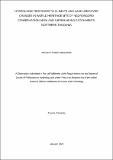| dc.description.abstract | In Tanzania, various studies have analyzed the impact of climate and land use/cover changes
on water resources. However, information on the interactions between climate and land
use/cover change, temporal and spatial variability of hydrological components and water
quality at the local scale is insufficient. The objective of this study was to evaluate the
hydrological response to climate and land use/cover changes in Ngorongoro Conservation Area
(NCA) and surroundings. The study performed climate change analysis using outputs from a
multi-model ensemble of Regional Climate Models (RCMs) and statistically downscaled
Global Climate Models (GCMs). The CA–Markov model applied to project Land use/cover
for the future 2025 and 2035. This study further used the Soil Water Assessment Tool (SWAT)
modelling approaches to analyse the hydrological responses and HYDRUS 1D to determine
the change in Groundwater quality due to climate and land use/cover changes. The analysis of
climate change between historical period (1982-2011) and future period (2021-2050) indicated
an increase in the mean annual rainfall and temperature, seasonal rainfall except June to
September (JJAS) season which showed a decreasing trend. Spatially, rainfall and temperatures
would increase over the entire area. The projected Land use/cover change for the period 2025
to 2035 compared to the baseline 2016, showed a reduction in bushland, forest, water, and
woodland, but an intensification in cultivated land, grassland, bare land, and the built-up area.
The surface runoff, evapotranspiration, lateral flow, and water yield would significantly
increase in the future, while groundwater would decrease under combined climate and land
use/cover change. It is predicted that two anions (Cl−
and PO4
−3
) and two cations (Na+
and K+
)
would exceed the permissible limits for the drinking water set by the World Health organisation
(WHO) and Tanzania Bureau of Standards (TBS), from 2036 to 2050. Changes in groundwater
quality due to major cations and anions is significantly correlated to evapotranspiration and
temperature with Pearson correlation (r) between 0.35 and 0.85. Furthermore, correlate to the
changes in all land use/ cover types with Pearson correlation (r) between 0.56 and 0.96. The
results obtained provide further insight into future water resources management planning and
adaptation strategie | en_US |

